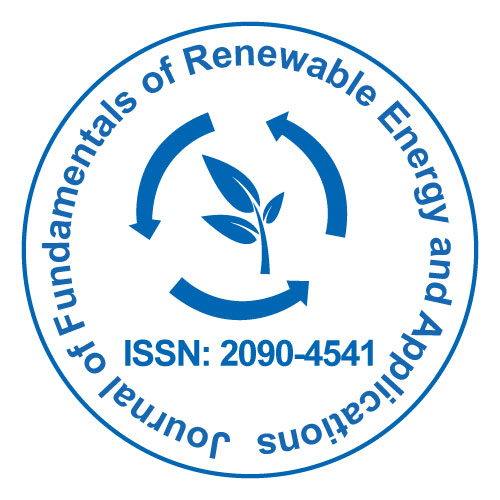
Journal of Fundamentals of Renewable Energy and Applications
Open Access
ISSN: 2090-4541
+44 1300 500008

ISSN: 2090-4541
+44 1300 500008
Perspective - (2024)Volume 14, Issue 3
Transitioning to renewable energy sources has become a major concern as the globe struggles with the urgent need to cut greenhouse gas emissions and combat climate change. Among the many renewable options, geothermal energy offers a unique and largely untapped solution for decarbonizing the energy sector. By harnessing the heat stored within the Earth’s crust, geothermal energy provides a reliable and sustainable alternative to fossil fuels. This essay explains the potential of geothermal energy, its role in decarbonization, and the challenges and opportunities it presents in achieving a low-carbon future. Geothermal energy can also be used for direct heating applications, such as space heating, greenhouse heating, and industrial processes.
Geothermal energy is a key player in the transition to a decarbonized energy system for several reasons. Geothermal power plants produce very low greenhouse gas emissions compared to fossil fuel-based energy sources. This makes geothermal energy a key tool for reducing the carbon footprint of electricity generation. In areas where geothermal resources are abundant, such as Iceland, geothermal power provides a substantial share of the country’s electricity and heating needs, drastically reducing reliance on fossil fuels. One of the most significant advantages of geothermal energy is its ability to provide baseload power. This makes it a reliable and consistent source of electricity, contributing to grid stability and reducing the need for backup power from fossil fuel plants. In countries like Kenya and the Philippines, geothermal energy provides a stable supply of electricity, helping to balance the intermittency of other renewable sources. Geothermal district heating systems, for example, provide heat to entire communities by tapping into hot water reservoirs beneath the Earth’s surface. This can significantly reduce the carbon emissions associated with heating buildings, which is a major source of greenhouse gases, particularly in colder climates. Geothermal heat pumps offer an energy-efficient method for heating and cooling buildings. These systems take advantage of the relatively constant temperatures just below the earth’s surface to provide year-round climate control. By using 25%-50% less electricity than conventional heating and cooling systems, geothermal heat pumps can contribute significantly to energy savings and carbon reduction in the building sector.
Despite its many advantages, geothermal energy faces several challenges that have limited its widespread adoption. Highquality geothermal reservoirs are often located in tectonically active regions, such as the Pacific Ring of Fire, which limits the global potential for geothermal power generation. Additionally, exploring and identifying viable geothermal sites can be costly and time-consuming. Drilling deep into the Earth’s crust to access geothermal reservoirs requires significant upfront investment, and there is always a risk that a site may not produce sufficient heat or fluid to be economically viable. Although geothermal energy is considered a clean and renewable resource, it is not without environmental risks. In some cases, geothermal plants can release small amounts of greenhouse gases, such as CO2, methane (CH4), and hydrogen sulfide (H2S), from underground reservoirs. Additionally, geothermal operations can cause localized subsidence (ground sinking) and, in rare cases, induce seismic activity, particularly in areas with Enhanced Geothermal Systems (EGS), where water is injected into hot rock formations to create artificial reservoirs. Compared to other renewable energy sources like solar and wind, geothermal energy often receives less attention and policy support. Public awareness of geothermal energy’s potential is relatively low, and many governments prioritize investment in more visible technologies. To accelerate the adoption of geothermal energy, greater public and political recognition of its benefits is needed, along with policies that support research, development, and deployment.
Advances in drilling technology, seismic imaging, and Enhanced Geothermal Systems (EGS) are helping to overcome some of the barriers associated with geothermal energy. EGS, in particular, has the potential to unlock vast amounts of geothermal energy in regions where natural geothermal reservoirs are not present. By creating artificial reservoirs in hot, dry rock formations, EGS could expand the geographic range of geothermal power generation and make it a viable option in more areas. This hybrid approach can enhance grid stability and reduce the need for fossil fuel backup power.
Geothermal energy represents a powerful and reliable tool in the global effort to decarbonize the energy sector. With its low carbon emissions, baseload power generation, and direct heating applications, geothermal energy can play an important role in reducing greenhouse gas emissions and transitioning to a sustainable energy future. While challenges such as high initial costs and resource location remain, ongoing technological advancements and increased policy support could unlock the full potential of geothermal energy, making it a cornerstone of the global renewable energy transition. As the world continues to seek solutions to the climate crisis, geothermal energy stands out as a key component in the path toward a decarbonized energy sector.
Citation: Grace L (2024). Geothermal Energy and the Path to Decarbonizing the Energy Sector. J Fundam Renewable Energy Appl. 14:357.
Received: 30-Aug-2024, Manuscript No. JFRA-24-34386; Editor assigned: 02-Sep-2024, Pre QC No. JFRA-24-34386 (PQ); Reviewed: 16-Sep-2024, QC No. JFRA-24-34386; Revised: 23-Sep-2024, Manuscript No. JFRA-24-34386 (R); Published: 30-Sep-2024 , DOI: 10.35248/2090-4541.24.14.357
Copyright: © 2024 Grace L. This is an open-access article distributed under the terms of the Creative Commons Attribution License, which permits unrestricted use, distribution and reproduction in any medium, provided the original author and source are credited.